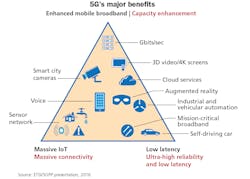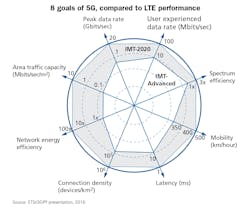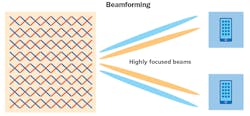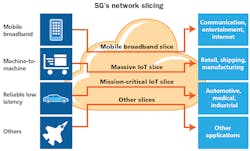By Art King, Corning Optical Communications
Friends, has any of these happened to you?
A colleague says, “5G can solve that!”
You read, “This new feature will require 5G.”
An advertisement declares, “5G can do this!”
For each of the situations above, if you’re a little unclear on how 5G fits into each of them, please read on. We wrote this article to help integrators and enterprises understand the origins, goals, and underlying technology of 5G.
We think that enterprise technology buyers need to be better equipped with basic 5G knowledge in order to have good conversations with internal line of business customers and vendors. Without this fundamental knowledge, both providing leadership to your business on 5G needs or managing vendors pitching 5G solutions could be more challenging.
Without further delay, let’s explore 5G from its major benefits and technical goals, all the way down to the new technology that makes up its building blocks.
Major benefits of 5G
As the three major benefits of 5G are discussed, the included diagram shows numerous network applications that are located within the triangle where the location indicates the most influential benefits.
1. Enhanced mobile broadband/capacity enhancements—Increasing capacity in the network is vital to satisfy the performance requirements of applications and people. In mobile networks, poor capacity is experienced as great coverage with extremely slow service or “5 bars of nothing.” As we move to 5G, the twin goals of increased speed and increased density require a huge increase in network capacity to deliver the promised performance.
2. Massive IoT/massive connectivity—Enabling many more applications and people with cellular service requires mobile networks to support a level of device density that is rarely seen today outside of stadiums. The architects of 5G, knowing that mobile operators cannot blanket a country with stadium-class infrastructure, have addressed device density in it.
3. Low latency/ultra-high reliability and low latency—Latency is the round-trip time between two systems such as a self-driving car and its navigational infrastructure. Imagine this: In a remote surgery scenario, the feedback to the surgeon must be as immediate as possible to ensure that the surgeon’s actions are not slowed or limited by network latency. There are many other industrial latency problems with older wireless technologies that have prevented them from moving off fixed cabling. 5G is architected to deliver a substantially lower latency to be able to support these applications.
Ultra-high reliability is targeted in increasing the availability of 5G so that self-driving cars or other industrial machines and processes can be implemented with a higher degree of assurance around availability of network services.
To summarize the major benefits in one sentence: 5G delivers a highly reliable low-latency network that supports more devices at a faster data rate.
Technical goals of 5G
The 8 goals of 5G are visually outlined in the radar diagram. These goals combine to deliver the three major benefits. The goals are an evolution of the original LTE specifications. The International Telecommunications Union (ITU) IMT-2020 working group created them in 2015 at the start of the 5G design process. The 8 technical goals are described here.
1. User experienced data rate (Mbits/sec)—Improved by 10x from 10 to 100 Mbits/sec. Resulting data rate at the mobile device that is extracted from the cellular signal transmitted over the air.
2. Spectrum efficiency—Comparison where 5G is 3x more efficient than LTE. Spectrum efficiency is the information rate over a channel. When 5G and LTE transmit in same channel width, 5G is 3x better.3. Mobility (km/h)—Improved from 350 to 500 km/h. Fastest speed that the network can hand over active sessions from cell to cell. Most important in high-speed rail, drones, or other applications where the mobile device is moving at exceptional speeds.
4. Latency (ms)—Improved by 10x from 10ms down to 1ms. Important to any application that must have lightning-fast replies from the systems they are connected to.
5. Connection density (devices/km2)—Improved by 10x from 100,000 to 1,000,000 devices/km2. As more devices are attached in dense urban areas, the network has to be able to service them.
6. Network energy efficiency—Comparison where 5G is 100x more efficient than LTE. The accumulated benefits result from every aspect of the network being consciously architected to consume far less power.
7. Area traffic capacity (Mbit/sec/m2)—Improved by 10x from 1 to 10 Mbits/sec/m2. Capacity available to each mobile device is increased. When the increase in area traffic capacity is combined with increase in connection density, the network usage across the area could increase by as much as 100x.
8. Peak data rate (Gbits/sec)—Improved by 20x from 1 to 20 Gbits/sec. Over-the-air data rate at the cell infrastructure.
To summarize the technical goals in one sentence: 5G delivers a highly reliable network that has 10x more devices attached to it, in the same area, with a 10x faster data rate available to each device while reducing latency by 10x.
Technologies behind 5G
The 5G specifications introduce four new building blocks relating to infrastructure. Each of them is very complex in and of themselves. Please refer to additional ITU documents for more detail as we are briefly outlining each block and cannot fully do them justice in the space available.
5G-NR: 5G-New Radio (5G-NR) is a descendant of the LTE air interface that offers a maximum spectrum bandwidth of 400 MHz (LTE has 20 MHz), and two spectrum ranges defined, called F1 and F2. F1 supports spectrum under 6 GHz, also referred to as sub-6 GHz. F2 supports spectrum from 24 GHz and up, also referred to as millimeter wave or mmWave.
One of the questions that is commonly asked is, how fast is the 5G radio? Maximum speed is a complex question. The reality is that maximum speed depends on the spectrum available to the mobile operator and how they configure their 5G network. As we know from the discussion of the 8 goals, the best-case peak network rates are expected to be 20 Gbits/sec (20x today’s LTE) and user-experienced data rates of 100 Mbits/sec (10x current LTE).
Deployment of 5G radio access networks (RAN): Little known fact: The LTE networks that exist today are used as part of the 5G RAN. Why? Given the country is too large to activate 5G everywhere at the same time, U.S. mobile operators are implementing a 5G deployment mode called 5G-Non-Standalone (5G-NSA), where the system combines an existing LTE channel for 5G signaling and a 5G-NR channel for user data between a 5G-NSA cell and attached 5G-capable mobile devices. 5G-NSA was selected because it will continue to provide a positive user experience for all as the 5G network is being rolled out nationwide.The future configuration of the RAN is called 5G-Standalone or 5G-SA that carries all signaling traffic and user data on 5G-NR channel(s). Once most mobile devices have been refreshed to 5G-capable devices and LTE is declining, the RAN will be migrated from the 5G-NSA configuration to a final 5G-SA configuration.
Massive MIMO: Multiple input and multiple output (MIMO)—pronounced “my-moe”—is a method for multiplying the capacity of a radio link by using multiple transmit and receive antennas. MIMO is used extensively in WiFi and LTE to provide better service to laptops and mobile devices. Typically, the antenna count is between 2 to 8 on the WiFi access point or cell site.
Massive MIMO is an evolution of MIMO that includes the following.
Ultra-reliable and low latency communications (URLLC): URLLC is a collection of software and hardware techniques to enable high-availability, low-latency, and, in some cases, bounded jitter for critical application-performance needs. URLLC is defined in the 3GPP Release 16 and 17 specifications. Among the techniques included in these specifications are the following.
- Massive MIMO antenna spatial diversity capability to maintain multiple connections to an attached device
- Multiple connections to an attached device by multiple antennas
- Enable privileged flows to have priority access to radio uplink/downlink
- Allocation of reservations in the system for privileged flows
- Edge computing to support fast application responses by either hosting standalone edge application or a subset of a cloud application
In the remote-surgery example presented earlier, haptic feedback to the surgeon (where they “feel” the resistance of their tool) has a roundtrip time requirement of as low as 1ms. An edge computing implementation saves the time delay of going all the way to the cloud service for the feedback replay.
At its debut, URLLC will provide a platform for application developers to build services in mobile networks that deliver the fast, local response required for industrial robotics, remote surgery, factory 4.0, and other time-sensitive/high-value scenarios.Commercial release of systems is anticipated in the 2021-2022 timeframe. The URLLC technology framework is anticipated to continuously evolve over time as experience with it develops.
Network slicing: When 5G-SA replaces the 5G-NSA network configuration, the concept of network slicing can be introduced into the mobile network. 5G network slicing is a framework that enables service providers to create virtual end-to-end networks tailored to application requirements. Network slicing creates multiple virtual networks on top of a commonly shared physical infrastructure. Each slice is customized to meet specific needs of applications, services, devices, or customers and is an end-to-end logical network that is created with resources from the 5G device, RAN, URLLC, backhaul, core network, and even cloud services. Each slice will have its own programmed behavior when it is created for a specific use or application.
The benefit of network slicing is the division of a single physical network infrastructure into multiple isolated, end-to-end virtual networks that support a wide range of services, applications, and will be optimized for specific business purposes.
Commercial release of systems is anticipated in the 2021-2022 timeframe. Slicing will require a significant investment in end-to-end service orchestration. Slices, because they have to span every system in the mobile operator, must be fully automated. Note that prior to 5G-SA conversion, there may be limited deployment of slicing in the 5G-NSA network configuration with an LTE core network.In summary
After considering the materials we have covered, if you are in an enterprise role and will be involved in 5G projects, it is recommended that you develop a broader understanding of the four building-block technologies to aid in technology selection and vendor management.
Today, if a vendor presents you a solution that requires the 5G network, this article enables you to ask two basic questions: 1) What 5G building blocks does the solution leverage? 2) Can it use LTE in advance of 5G availability and what are the risks?
And finally, here is a short takeaway list that connects 5G benefits to the underlying technology infrastructure.
5G is the first “G” that is not just a faster radio network.
5G offers 3 major benefits.
5G has 8 technical goals that combine to deliver the 3 major benefits.
5G uses 4 technology building blocks that combine to meet the 8 technical goals.
Art King is director of enterprise services with Corning Optical Communications.





